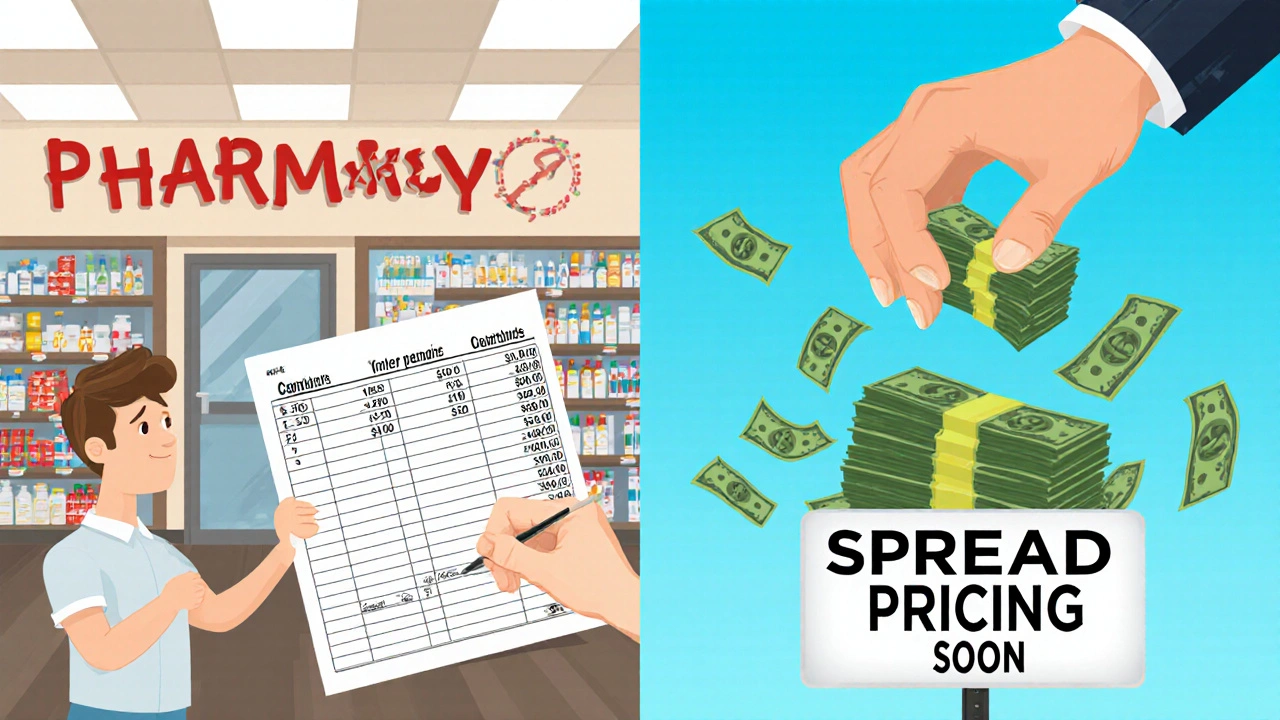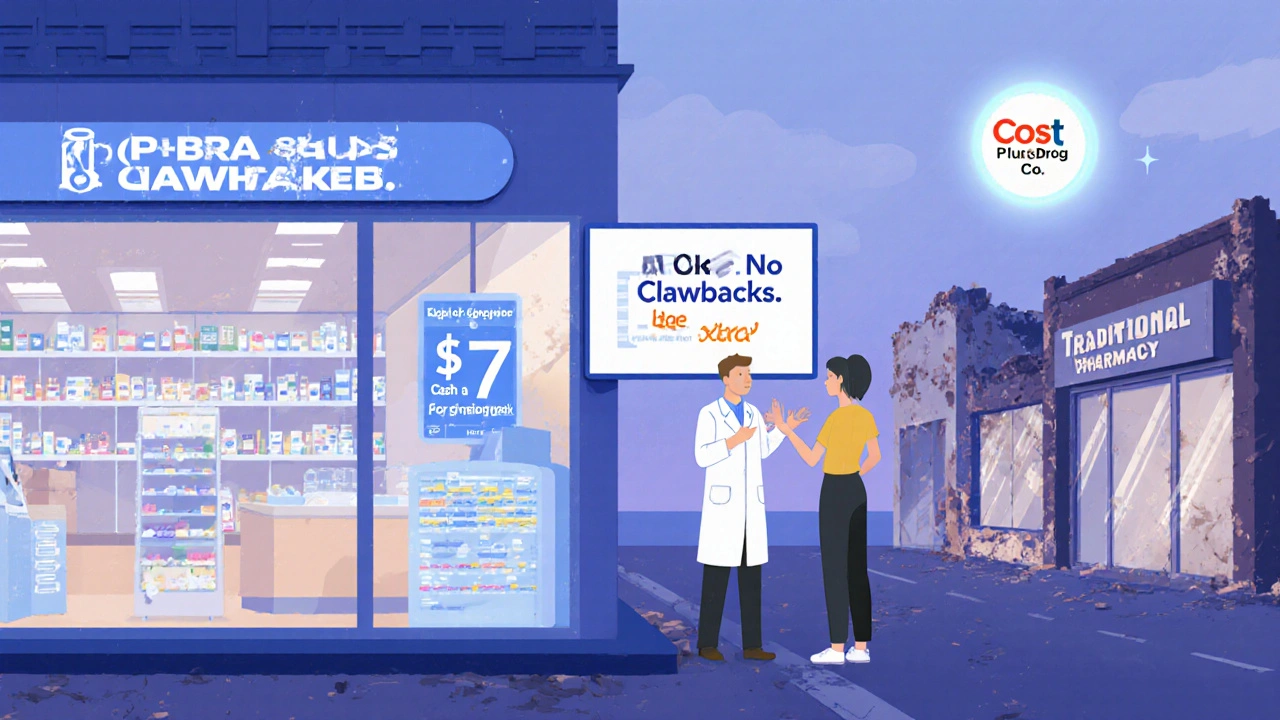Most people think expensive brand-name drugs are what keep pharmacies in business. But the truth is, pharmacies make almost all their profit from the cheapest pills on the shelf: generics. In the U.S., generics make up 90% of all prescriptions filled, yet they only account for about 25% of total drug spending. That’s because brand-name drugs cost hundreds or even thousands of dollars per prescription, while generics often cost less than $5. So how do pharmacies turn low-cost generics into their main source of income? It’s not magic-it’s math, and it’s broken.
Why Generics Are the Real Profit Engine
Here’s the counterintuitive part: pharmacies earn 42.7% gross margin on generic drugs, but only 3.5% on brand-name ones. That means for every $100 spent on a generic prescription, the pharmacy pockets about $43 before paying rent, staff, or utilities. For a brand-name drug? Just $3.50. So even though brand drugs make up most of the money spent by patients and insurers, pharmacies rely on generics to stay afloat.
This isn’t accidental. It’s how the system was built. After the Hatch-Waxman Act of 1984 made it easier to approve generic versions of brand drugs, manufacturers started flooding the market with cheaper alternatives. Pharmacies responded by marking up these low-cost pills heavily. A $2 generic pill might sell for $15. The difference-$13-is pure profit. Meanwhile, a $500 brand drug might only be marked up to $520. That $20 difference doesn’t go far when you’re paying rent, salaries, and insurance claims.
According to the Schaeffer Center, pharmacies make about $32 in gross profit per generic prescription, compared to just $3 per brand prescription. That’s why, even though generics make up less than a third of total drug sales, they account for 96% of pharmacy margins. The math is brutal: without generics, most independent pharmacies would lose money on every prescription they fill.
Who Really Gets Rich Off Generics?
It’s not just the pharmacy. The whole supply chain is built on this imbalance. Manufacturers of generics make about 49.8% gross margin-far less than brand drug makers, who clear 76.3%. But downstream, the money shifts. Pharmacy benefit managers (PBMs) make four times more on generics than brands. Wholesalers make eleven times more. And pharmacies? They make nearly twelve times more profit on generics.
But here’s the catch: that $32 profit per generic prescription doesn’t end up in the pharmacist’s pocket. Most of it gets eaten up by PBMs using a practice called spread pricing. Here’s how it works: a PBM tells the insurance plan they’re paying $10 for a generic drug. They tell the pharmacy they’re reimbursing $8. They keep the $2 difference. That’s spread pricing. Sometimes, the pharmacy gets paid even less than what they paid the wholesaler. When that happens, the pharmacy loses money-but still has to fill the prescription.
And it gets worse. Many PBMs use clawbacks. The pharmacy gets reimbursed $10 for a $5 generic. Later, the PBM says, “Oops, the real cost was $7. You owe us $3.” The pharmacy has to pay back the difference, often from their own cash flow. Independent pharmacies report losing $100-$500 a week to clawbacks alone.
The Death of the Independent Pharmacy
Over the last decade, more than 3,000 independent pharmacies have closed across the U.S. Why? Because the system is rigged against them. Big chains like CVS and Walgreens have their own PBMs. They negotiate better reimbursement rates. They get bulk discounts. They even own the insurance plans that pay for the drugs. Independent pharmacies? They’re stuck with whatever the big three PBMs-CVS Caremark, Express Scripts, and OptumRx-decide to pay them.
These three companies control about 80% of all prescription transactions. That gives them total power over pricing. A 2022 survey by the National Community Pharmacists Association found that 68% of independent pharmacy owners listed declining generic reimbursement as their top threat. Gross margins on generics have dropped from 24.6% in 2015 to 19.8% in 2022. Meanwhile, overhead costs-rent, insurance, staff wages-have jumped 35% in the same period.
Some owners say they’re now making barely 2% net profit after all expenses. That’s not a business. That’s a volunteer job with a pharmacy license. One Ohio pharmacy owner told Pharmacy Times, “I used to make 8-10% net on generics. Now I’m lucky to break even.”

When Generics Cost More Than Brands
Here’s another twist: sometimes, generics cost more than the brand-name drug. How? When only one company makes the generic. That’s called a single-source generic. Without competition, that manufacturer can raise prices. In some cases, the single-source generic is priced higher than the original brand. SureCost’s 2024 white paper documented cases where patients paid more for the generic than the brand-because the brand had a discount coupon, but the generic had no competition.
Between 2014 and 2016, nearly 100 mergers happened in the generic manufacturing space, worth close to $80 billion. The result? Fewer companies making fewer generics. Less competition. Higher prices. The FDA says prices drop by about 20% when three or more companies make the same generic. But when there’s only one? Prices spike. And pharmacies get stuck paying more for the very drugs they rely on to make money.
How Some Pharmacies Are Fighting Back
Not all pharmacies are giving up. Some are changing the rules.
Mark Cuban’s Cost Plus Drug Company charges a flat $20 for generics plus a $3 dispensing fee. No spreads. No clawbacks. No mystery. They publish every cost. And they’re processing over a million prescriptions a month. Amazon Pharmacy does something similar-$5 for generics, clear pricing, no hidden fees.
Other pharmacies are ditching PBMs entirely. They go direct to employers or offer cash-pay models for select medications. One pharmacy in Texas stopped accepting insurance for 20 common generics and started charging $7 cash. Their net profit jumped from 1.5% to 6%. They lost some insurance patients-but gained loyal customers who appreciated the transparency.
Some are shifting into medication therapy management (MTM). Instead of just filling prescriptions, pharmacists now spend 20-30 minutes with patients to review all their meds, catch interactions, and help with adherence. Medicare pays pharmacies $100-$150 per MTM session. That’s more than they make on 20 generic prescriptions. It’s a better business model-and it improves health outcomes.

What’s Next? Regulation, Disruption, or Collapse
The federal government is starting to pay attention. The FTC has launched investigations into PBM practices. In 2023, they held a workshop specifically on pharmacy reimbursement. States like California, Texas, and Illinois have passed laws requiring PBMs to disclose how they set reimbursement rates. The Inflation Reduction Act, starting in 2026, will let Medicare negotiate prices for some drugs. That could lower overall drug spending-and indirectly pressure PBM profits.
But the biggest threat to the current system isn’t regulation-it’s consumer awareness. When patients start asking, “Why is this $5 pill costing me $40?” and then go to Cost Plus Drug Company or Amazon Pharmacy, the old model cracks. Pharmacies that cling to the old way-relying on opaque spreads and clawbacks-won’t survive.
The future belongs to pharmacies that become health partners, not just pill dispensers. Those that offer MTM, direct pricing, or transparent cost models will thrive. Those that don’t? They’ll join the 3,000 that already closed.
What You Can Do
If you’re a patient: always ask if a generic is available. Compare cash prices. Use apps like GoodRx. Sometimes, paying cash is cheaper than using insurance.
If you’re a pharmacy owner: stop relying on PBM reimbursements. Build direct relationships with local employers. Offer MTM services. Go cash-only for common generics. You’ll lose some volume-but you’ll keep your profit.
If you’re a policymaker: demand transparency. End spread pricing. Ban clawbacks. Require PBMs to report their margins. The system isn’t broken-it was designed this way. And it’s designed to fail independent pharmacies.
Generics were supposed to save money. They did-for drug makers and PBMs. But for the pharmacies on the front lines? They’re still paying the price.


Post A Comment